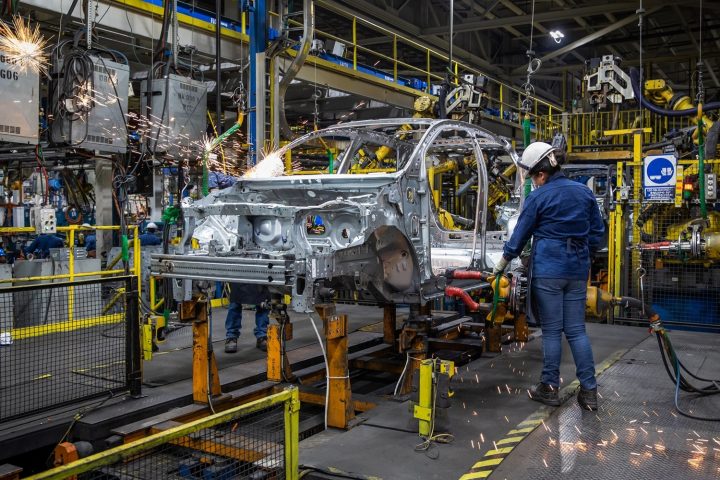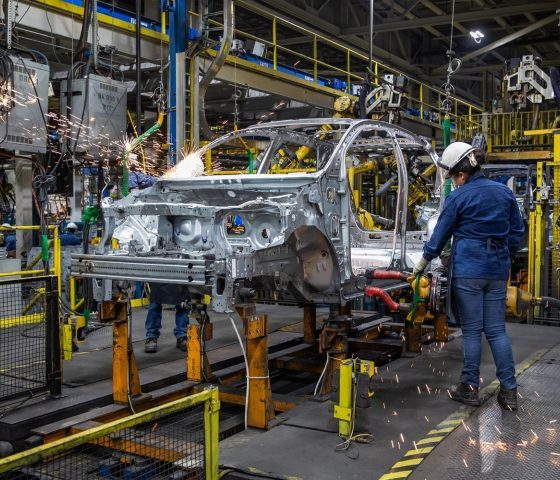GM is reportedly considering expanding EV production to its existing Ramos Arizpe plant in northern Mexico.
General Motors (GM) and other major American automakers have long had a presence South of the United States. Even now, vehicles like the Chevy Trax, Jeep Compass, and the ever-popular Chevy Silverado are produced en masse across the border in Mexico. Now, the most prominent American auto group is also considering expanding its EV production to Mexico.
The Mexican Economic Ministry announced that GM would be expanding EV production to the country via a tweet showing leaders from both parties discussing it yesterday.
La Sria. de Economía, Raquel Buenrostro, se reunió con General Motors. Informaron que en 2024 su complejo industrial de Ramos Arizpe, Coahuila, producirá solo vehículos eléctricos. Anunciaron el incremento de 5 mil empleos, fomentando la inclusión de género en su plantilla. pic.twitter.com/qatRlGLLwO
— Economía México (@SE_mx) January 3, 2023
The first tweet reads:
“The [Economic Minister], Raquel Buenrostro, met with General Motors. They reported that by 2024 their industrial complex in Ramos Arizpe, Coahuila, will produce only electric vehicles. They announced the increase of 5,000 jobs, promoting the inclusion of gender in their workforce.”
The second tweet clarifies, saying:
“The increase in jobs has been generated during this six-year term in the San Luis Potosí and Ramos Arizpe plants, resulting in a total of 4,500.”
According to the tweet from the Mexican Ministry, the Ramos Arizpe plant will be shifting to 100% EV production this year and aims to begin full production sometime in 2024. This follows news that GM had been increasing its workforce in Mexico by roughly 4,500, according to a clarifying tweet from the Ministry.
Mexico has become a hotspot for EV production over the past few years. Its location near the United States, cheaper labor, and its access to U.S. Federal EV incentives have made it a prime location for new EV production. This has attracted the likes of Ford and Tesla and is likely influencing brands like GM, Hyundai/Kia, and BMW, which already have significant production facilities in the country.
GM nor the Mexican Economic Ministry specified what vehicles the American auto giant would be producing at its revamped production facility, but it’s possible to make an educated prediction.
The Ramos Arizpe plant currently produces the Chevy Equinox and Chevy Blazer ICE vehicles. And coincidently, both of these vehicles will be available as electric models in the coming years. Hence, with the facility’s familiarity with the products and the production date of 2024 matching the introduction date of the two Chevy EV SUVs, it would not be surprising if they were produced at the revamped facility.
GM has not specified if existing ICE vehicle production lines would be halted. Still, with its recent hiring, one would anticipate that it is opening a new production line for strictly EVs.
It is no surprise that the General chose the Ramos Arizpe plant to produce EVs. Mear miles from Monterey, it is within a stone’s throw of the proposed location for the upcoming Tesla plant. And while GM is likely not basing its decision on its competition’s new location, both automakers have probably been lured to the site not only for the aforementioned cheaper labor and quick access to the U.S. market but also for the safety and infrastructure available in the area.
According to the U.S. State Department travel advisory site, the area of Monterey is safer than other border locations, including Baja California and the State of Tamaulipas. At the same time, the locations chosen by both manufacturers are serviced by one of the largest highways going into the United States, Mexico Route 85/U.S. Interstate 35.
It is a positive sign to see the behemoth of General Motors finally changing course toward electric vehicles. And while its recently announced products have been fantastic to hear about, announcing production changes is more concrete evidence of the change happening behind the scenes. And whatever the company decides to build at its Mexican facility, you can count me as excited to see it come to fruition.
What do you think of the article? Do you have any comments, questions, or concerns? Shoot me an email at william@teslarati.com. You can also reach me on Twitter @WilliamWritin. If you have news tips, email us at tips@teslarati.com!

Elon Musk
Elon Musk and Tesla AI Director share insights after empty driver seat Robotaxi rides
The executives’ unoccupied tests hint at the rapid progress of Tesla’s unsupervised Robotaxi efforts.

Tesla CEO Elon Musk and AI Director Ashok Elluswamy celebrated Christmas Eve by sharing personal experiences with Robotaxi vehicles that had no safety monitor or occupant in the driver’s seat. Musk described the system’s “perfect driving” around Austin, while Elluswamy posted video from the back seat, calling it “an amazing experience.”
The executives’ unoccupied tests hint at the rapid progress of Tesla’s unsupervised Robotaxi efforts.
Elon and Ashok’s firsthand Robotaxi insights
Prior to Musk and the Tesla AI Director’s posts, sightings of unmanned Teslas navigating public roads were widely shared on social media. One such vehicle was spotted in Austin, Texas, which Elon Musk acknowleged by stating that “Testing is underway with no occupants in the car.”
Based on his Christmas Eve post, Musk seemed to have tested an unmanned Tesla himself. “A Tesla with no safety monitor in the car and me sitting in the passenger seat took me all around Austin on Sunday with perfect driving,” Musk wrote in his post.
Elluswamy responded with a 2-minute video showing himself in the rear of an unmanned Tesla. The video featured the vehicle’s empty front seats, as well as its smooth handling through real-world traffic. He captioned his video with the words, “It’s an amazing experience!”
Towards Unsupervised operations
During an xAI Hackathon earlier this month, Elon Musk mentioned that Tesla owed be removing Safety Monitors from its Robotaxis in Austin in just three weeks. “Unsupervised is pretty much solved at this point. So there will be Tesla Robotaxis operating in Austin with no one in them. Not even anyone in the passenger seat in about three weeks,” he said. Musk echoed similar estimates at the 2025 Annual Shareholder Meeting and the Q3 2025 earnings call.
Considering the insights that were posted Musk and Elluswamy, it does appear that Tesla is working hard towards operating its Robotaxis with no safety monitors. This is quite impressive considering that the service was launched just earlier this year.
Elon Musk
Starlink passes 9 million active customers just weeks after hitting 8 million
The milestone highlights the accelerating growth of Starlink, which has now been adding over 20,000 new users per day.

SpaceX’s Starlink satellite internet service has continued its rapid global expansion, surpassing 9 million active customers just weeks after crossing the 8 million mark.
The milestone highlights the accelerating growth of Starlink, which has now been adding over 20,000 new users per day.
9 million customers
In a post on X, SpaceX stated that Starlink now serves over 9 million active users across 155 countries, territories, and markets. The company reached 8 million customers in early November, meaning it added roughly 1 million subscribers in under seven weeks, or about 21,275 new users on average per day.
“Starlink is connecting more than 9M active customers with high-speed internet across 155 countries, territories, and many other markets,” Starlink wrote in a post on its official X account. SpaceX President Gwynne Shotwell also celebrated the milestone on X. “A huge thank you to all of our customers and congrats to the Starlink team for such an incredible product,” she wrote.
That growth rate reflects both rising demand for broadband in underserved regions and Starlink’s expanding satellite constellation, which now includes more than 9,000 low-Earth-orbit satellites designed to deliver high-speed, low-latency internet worldwide.
Starlink’s momentum
Starlink’s momentum has been building up. SpaceX reported 4.6 million Starlink customers in December 2024, followed by 7 million by August 2025, and 8 million customers in November. Independent data also suggests Starlink usage is rising sharply, with Cloudflare reporting that global web traffic from Starlink users more than doubled in 2025, as noted in an Insider report.
Starlink’s momentum is increasingly tied to SpaceX’s broader financial outlook. Elon Musk has said the satellite network is “by far” the company’s largest revenue driver, and reports suggest SpaceX may be positioning itself for an initial public offering as soon as next year, with valuations estimated as high as $1.5 trillion. Musk has also suggested in the past that Starlink could have its own IPO in the future.
News
NVIDIA Director of Robotics: Tesla FSD v14 is the first AI to pass the “Physical Turing Test”
After testing FSD v14, Fan stated that his experience with FSD felt magical at first, but it soon started to feel like a routine.

NVIDIA Director of Robotics Jim Fan has praised Tesla’s Full Self-Driving (Supervised) v14 as the first AI to pass what he described as a “Physical Turing Test.”
After testing FSD v14, Fan stated that his experience with FSD felt magical at first, but it soon started to feel like a routine. And just like smartphones today, removing it now would “actively hurt.”
Jim Fan’s hands-on FSD v14 impressions
Fan, a leading researcher in embodied AI who is currently solving Physical AI at NVIDIA and spearheading the company’s Project GR00T initiative, noted that he actually was late to the Tesla game. He was, however, one of the first to try out FSD v14.
“I was very late to own a Tesla but among the earliest to try out FSD v14. It’s perhaps the first time I experience an AI that passes the Physical Turing Test: after a long day at work, you press a button, lay back, and couldn’t tell if a neural net or a human drove you home,” Fan wrote in a post on X.
Fan added: “Despite knowing exactly how robot learning works, I still find it magical watching the steering wheel turn by itself. First it feels surreal, next it becomes routine. Then, like the smartphone, taking it away actively hurts. This is how humanity gets rewired and glued to god-like technologies.”
The Physical Turing Test
The original Turing Test was conceived by Alan Turing in 1950, and it was aimed at determining if a machine could exhibit behavior that is equivalent to or indistinguishable from a human. By focusing on text-based conversations, the original Turing Test set a high bar for natural language processing and machine learning.
This test has been passed by today’s large language models. However, the capability to converse in a humanlike manner is a completely different challenge from performing real-world problem-solving or physical interactions. Thus, Fan introduced the Physical Turing Test, which challenges AI systems to demonstrate intelligence through physical actions.
Based on Fan’s comments, Tesla has demonstrated these intelligent physical actions with FSD v14. Elon Musk agreed with the NVIDIA executive, stating in a post on X that with FSD v14, “you can sense the sentience maturing.” Musk also praised Tesla AI, calling it the best “real-world AI” today.










